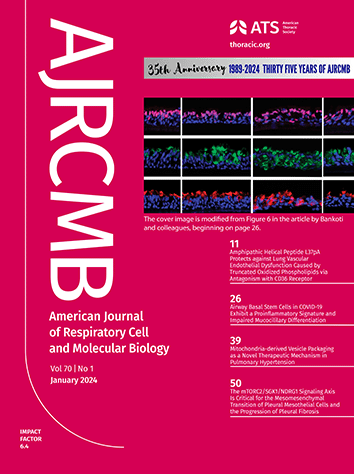Identification of SNHG11 as a Therapeutic Target in Pulmonary Hypertension.
IF 5.9
2区 医学
Q1 BIOCHEMISTRY & MOLECULAR BIOLOGY
American Journal of Respiratory Cell and Molecular Biology
Pub Date : 2024-09-12
DOI:10.1165/rcmb.2023-0428oc
引用次数: 0
Abstract
Pulmonary hypertension (PH) is a life-threatening condition characterized by pulmonary vascular remodeling and endothelial dysfunction. Current therapies primarily target vasoactive imbalances but often fail to address adverse vascular remodeling. Long non-coding RNA (lncRNA), which are key regulators of various cellular processes, remain underexplored in the context of PH. To investigate the role of lncRNA in PH, we performed a comprehensive analysis using Weighted Gene Co-expression Network Analysis (WGCNA) on the GSE113439 dataset, comprising human lung tissue samples from different PH subtypes. Our analysis identified the lncRNA SNHG11 as consistently downregulated in PH. Functional assays in human pulmonary artery endothelial cells (HPAECs) demonstrated that SNHG11 plays a critical role in modulating inflammation, cell proliferation, apoptosis, and the JAK/STAT and MAPK signaling pathways. Mechanistically, SNHG11 influences the stability of PRPF8, a crucial mRNA spliceosome component, thereby affecting multiple cellular functions beyond splicing. In vivo experiments using a hypoxic rat model showed that knockdown of SNHG11 alleviates PH development and improves right ventricular function. These findings highlight SNHG11 as a key regulator in PH pathogenesis and suggest it as a potential therapeutic target.确定 SNHG11 为肺动脉高压的治疗靶点
肺动脉高压(PH)是一种危及生命的疾病,其特点是肺血管重塑和内皮功能障碍。目前的疗法主要针对血管活性失衡,但往往无法解决不利的血管重塑问题。长非编码 RNA(lncRNA)是各种细胞过程的关键调控因子,但在 PH 方面的研究仍然不足。为了研究lncRNA在PH中的作用,我们使用加权基因共表达网络分析(WGCNA)对GSE113439数据集进行了全面分析,该数据集包括来自不同PH亚型的人类肺组织样本。我们的分析确定了lncRNA SNHG11在PH中持续下调。在人肺动脉内皮细胞(HPAECs)中进行的功能测试表明,SNHG11在调节炎症、细胞增殖、细胞凋亡以及JAK/STAT和MAPK信号通路方面起着关键作用。从机理上讲,SNHG11会影响mRNA剪接体的关键成分PRPF8的稳定性,从而影响剪接以外的多种细胞功能。利用缺氧大鼠模型进行的体内实验表明,敲除 SNHG11 可减轻 PH 的发展并改善右心室功能。这些发现凸显了SNHG11是PH发病机制中的一个关键调控因子,并建议将其作为一个潜在的治疗靶点。
本文章由计算机程序翻译,如有差异,请以英文原文为准。
求助全文
约1分钟内获得全文
求助全文
来源期刊
CiteScore
11.20
自引率
3.10%
发文量
370
审稿时长
3-8 weeks
期刊介绍:
The American Journal of Respiratory Cell and Molecular Biology publishes papers that report significant and original observations in the area of pulmonary biology. The focus of the Journal includes, but is not limited to, cellular, biochemical, molecular, developmental, genetic, and immunologic studies of lung cells and molecules.

 求助内容:
求助内容: 应助结果提醒方式:
应助结果提醒方式:


